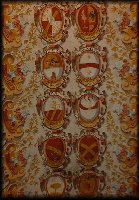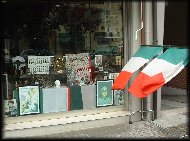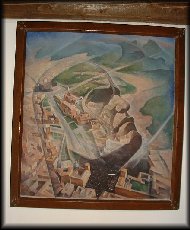Bologna & Predappio, Italy:
A Strange Encounter & Tea with Mussolini


Tea with Mussolini ? Noop, that was a movie made a few years ago. You can’t have tea with Italy’s wartime dictator now because he was executed in April 1945, but you can certainly visit his birthplace and mausoleum in Predappio in northern Italy. Last weekend, we flew into Bologna, and then drove around the north of Italy, visiting Predappio and the ancient Byzantine city of Ravenna, and did a little foray into the tiny Republic of San Marino, a mini-state totally surrounded by Italy.
Bologna, one of Italy’s most elegant and under-discovered cities. Site of the first university in Christian Europe (the first in Europe was in Cordoba, founded by the Moorish Arabs who once ruled Spain), and still a top university city in Italy, and of course, world famous for spaghetti bolognaise. We arrived here on a Friday evening, checked into our city-centre hotel, and soon found ourselves indulging in caffé latte and assorted pastries in a café right in the most elegant Piazza Maggiore, a wide square surrounded by the architectural gems of Mediaeval and Renaissance Europe. Here along the sides of this enormous square, arcaded walks called porticoes, mediaeval towers (including a leaning one, certainly less well known compared to its Pisan counterpart) and massive Romanesque palazzos combined to present what could be one of Italy’s most harmonious and spectacular Mediaeval cityscapes, although the presence of specific magnificent buildings in Florence, Rome and Venice means that Bologna attracts many less tourists than these cities.
 |
 |
 |
| Ceiling, Archiginnasio, Bologna | Mussolini souvenir shops in Predappio | Il Duce art at his birthplace museum |
Saturday – we woke up and walked around this beautiful city, had breakfast in a little café next to a local market, where the air was as much filled with Beethoven’s concertos from the café, and the neighbourhood signorita’s lament over the fishmonger’s prices. We bade farewell to the city, passing a boulevard that reminds us of Bologna’s leftist past (Stalingrado), and sped across the foggy plains of Emilia-Romagna, one of Italy’s richest regions and a land once dominated with city states many of which once formed part of the Pope’s personal fief, the Papal States.
About an hour’s drive from Bologna, we reached the dull
industrial city of Forli, where Benito Mussolini once worked as the editor at
Forli of a socialist newspaper, La Lotta di Classe (The Class Struggle),
and later became the local Socialist Party secretary – that was the time
before he switched drastically from being in the far left to the far right, to
found the Italian Fascist Party. Here
we struggled through the gridlock traffic that would have scandalized Mussolini
(whose Fascist admirers said made Italy “work”) into a small road across the
rolling hills to the south, to a little one-street town called Predappio.
This was where Mussolini was born and buried.
To be fair, the local tourist office did not pretend that Mussolini wasn’t born here. In fact, its leaflet mentioned that this was also the birthplace of Adone Zoli, a former Prime Minister well known for his anti-Fascist credentials. And then it went on to describe various Mussolini sites, plus a few mediaeval sites and local gastronomy – as though everybody comes here to enjoy local cheese and piadina (unleavened bread, specifically with tomato and mozzararella cheese, or otherwise with potato and turnip filling), topped with a glass of sangiovese.
Predappio, for an Italian town, seems to have a higher density of Italian flags than anywhere else, perhaps with the exception of Little Italy, New York. For a town that is quoted in no English guidebooks apart from the Cadogan Guide to Emilia-Romagna, Predappio has a surprising number of souvenir shops, all of which concentrate on only one theme – Mussolini and fascist souvenirs – Mussolini and fascist symbols on everything ranging from calendars, key chains, t-shirts, postcards, cups, towels, and what-have-you. Plus paintings, portraits and even sculptures of Il Duce, i.e., The Leader, in various heroic poses. Unbelievable! Just imagine if Linz decides to cash in on Hitler…
We parked our car near the
amphitheatre-like building in the center of town, where we saw a few tour buses
with Italian and German number plates, and headed for Mussolini’s house museum
on the hill behind. A smallish two-storey
house with more tourists than there were exhibits to see.
It’s purely an exhibition of fascist propaganda posters and a few
Mussolini-themed art objects. The
guys manning the ticket booth were friendly enough, telling us where to find
Mussolini’s tomb. Not sure if
this is a state-run museum, or belonging to some obscure Fascist museum trust.
San Cassiano Cemetery – this was where the Mussolini family mausoleum is found. The beautiful Romanesque church of San Cassiano greets one at the entrance. An elegant tree lined path leads to the far end of this cemetery where the church-like mausoleum of Mussolini rises above the surrounding area. A group of not-so-friendly-looking youth, probably members of some neo-fascist group on their pilgrimage to this shrine of their hero, were leaving the mausoleum, heading for their tour-bus. We were a little tensed. Would they be offended by the presence of a non-Aryan Asian visiting the shrine of their leader ? We had earlier joked about me pretending to be the member of a Japanese ultra-rightist group (since most people here mistook me as Japanese anyway), and G., pretending to be member of the extremist Australian One Nation Party. Maybe we need that sort of identity now… Fortunately, we were ignored and proceeded down the crypt of the mausoleum. Here, flowers and banners were laid across the tombs of the Mussolini family. Benito’s tomb lies against one wall of the crypt, with his uniform (forgot to take a closer look to see if they were blood-stained…wonder if that was the one he wore when executed by the partisans) and other relics displayed as well. What was amazing was that a young guy in black fascist uniform and robes stood as guard of honour over there. He stood still just like any guard one sees at presidential palaces and national war monuments or cemeteries round the world. He nodded his head when I asked if I could take pictures. A guest-book and a few leaflets were left on a table in front of the tomb. The leaflets invite visitors to become members of the Associazione Guardia d’Onore Benito Mussolini, complete with a hotmail address and telephone number. A less-informed visitor would conclude that Il Duce remains a national hero in this country.
Enough of Fascists and we decided to make our way to the tiny Republic of San Marino. Small it might be, the republic has an interesting story. That would merit a separate email. OK, I will write more.
Regards,
Wee-Cheng
Onward To The Republic of San Marino: A Small Republic That Said No To Napoleon
Use these books!
 Lonely
Planet: Italy
Lonely
Planet: Italy
Helen Gillman, Damien Simonis, et al
 Bologna
& Emilia Romagna - Cadogan Guide
Bologna
& Emilia Romagna - Cadogan Guide
Dana Facaros & Pauls Michael
Click here to send your comments to Tan Wee Cheng, Singapore
Click here to visit the author's homepage with tonnes of other travel stories!